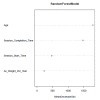Visual Analytics of Tuberculosis Detection Rat Performance
- PMID: 34659646
- PMCID: PMC8500793
- DOI: 10.5210/ojphi.v13i2.11465
Visual Analytics of Tuberculosis Detection Rat Performance
Abstract
The diagnosis of tuberculosis (TB) disease remains a global challenge, and the need for innovative diagnostic approaches is inevitable. Trained African giant pouched rats are the scent TB detection technology for operational research. The adoption of this technology is beneficial to countries with a high TB burden due to its cost-effectiveness and speed than microscopy. However, rats with some factors perform better. Thus, more insights on factors that may affect performance is important to increase rats' TB detection performance. This paper intends to provide understanding on the factors that influence rats TB detection performance using visual analytics approach. Visual analytics provide insight of data through the combination of computational predictive models and interactive visualizations. Three algorithms such as Decision tree, Random Forest and Naive Bayes were used to predict the factors that influence rats TB detection performance. Hence, our study found that age is the most significant factor, and rats of ages between 3.1 to 6 years portrayed potentiality. The algorithms were validated using the same test data to check their prediction accuracy. The accuracy check showed that the random forest outperforms with an accuracy of 78.82% than the two. However, their accuracies difference is small. The study findings may help rats TB trainers, researchers in rats TB and Information systems, and decision makers to improve detection performance. This study recommends further research that incorporates gender factors and a large sample size.
Keywords: African giant pouched rats; Classification Technique in Tuberculosis diagnosis; Data mining in healthcare.
This is an Open Access article. Authors own copyright of their articles appearing in the Journal of Public Health Informatics. Readers may copy articles without permission of the copyright owner(s), as long as the author and OJPHI are acknowledged in the copy and the copy is used for educational, not-for-profit purposes.
Conflict of interest statement
Conflicts of interest On behalf of all authors, the corresponding author states that there is no conflict of interest.
Figures
References
-
- World Health Organization. Global tuberculosis report 2018. New York, United States of America: WHO; 2018.
-
- Weetjens BJ, Mgode GF, Machang’u RS, Kazwala R, Mfinanga G, et al. 2009. African pouched rats for the detection of pulmonary tuberculosis in sputum samples. Int J Tuberc Lung Dis. 13, 737-43. - PubMed
LinkOut - more resources
Full Text Sources



